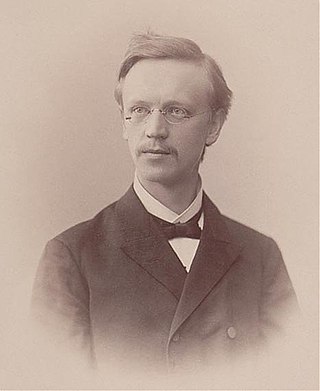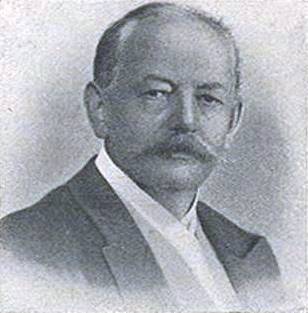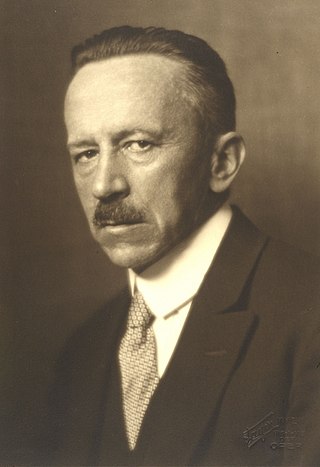
Ferdinand Albin Pax was a German botanist specializing in spermatophytes. A collaborator of Adolf Engler, he wrote several monographs and described several species of plants and animals from Silesia and the Carpathians. He was a professor at Wrocław University from 1893. His son Ferdinand Albert Pax (1885–1964) was a noted zoologist.

Heinrich Gustav Adolf Engler was a German botanist. He is notable for his work on plant taxonomy and phytogeography, such as Die natürlichen Pflanzenfamilien, edited with Karl A. E. von Prantl.

Anton Kerner Ritter von Marilaun, or Anton Joseph Kerner, was an Austrian botanist, physician, and professor at the University of Innsbruck and later at the University of Vienna. The standard author abbreviation A.Kern. is used to indicate this person as the author when citing a botanical name. Von Marilaun emphasized the concept of plant sociology or the species that plants were typically found associated with in his geographical studies of species. Inspired by the work of Alexander von Humboldt and others he examined climatological and historical factors in the distributions of plant species.
Günther Ritter Beck von Mannagetta und Lerchenau[a] was an Austrian botanist.

Karl Fritsch was an Austrian botanist. He was born in Vienna and educated mainly at the University of Vienna, obtaining his PhD degree in 1886 and his Habilitation in 1890. In 1900 he moved to the University of Graz as professor of Systematic Botany, where he built up the botanical institute. In 1910 he was appointed as director of the university's botanical garden, and in 1916 the new institute acquired its own building. He continued at Graz for the rest of his career, and died there.

Prof Władysław Szafer PAS HFRSE was a Polish botanist, palaeobotanist, quaternary geologist and professor of botany at the Jagiellonian University in Kraków. He was a world pioneer in nature conservation.
Viktor Ferdinand Brotherus was a Finnish botanist who studied the mosses (Bryophyta). He is best known for authoring the treatment of 'Musci' in Engler and Prantl's Die Naturlichen Pflanzenfamilien.

Bernhard Adalbert Emil Koehne was a German botanist and dendrologist born near Striegau, a town known today as Strzegom, Poland.

August von Hayek was an Austrian physician and botanist born in Vienna. He was the son of naturalist Gustav von Hayek and the father of economist Friedrich Hayek (1899–1992).

Alexander Zahlbruckner was an Austrian-Hungarian botanist who specialized in the study of lichens. Johann Babtist Zahlbruckner, an earlier Austrian botanist, was his grandfather.

Ernst Stizenberger was a German physician and lichenologist.
Bogumil Pawlowski was a Polish botanist, a member of the Polish Academy of Sciences, professor at the Jagiellonian University, and director of the Institute of Botany of the Academy of Sciences in Kraków.
Ernst Georg Pritzel was a German botanist.
Josef Schiller was an Austrian phycologist and hydrobiologist.
Victor Félix Schiffner was an Austrian bryologist specializing in the study of hepatics.

Gustav Albert Peter was a German botanist.
Karl Gottfried Erdmann was a German physician and botanist. He was the father of chemist Otto Linné Erdmann (1804–1869).
Lujo Adamović was a Serbian botanist and plant collector who was a leading authority regarding the genus Hieracium, recognized by the Food and Agriculture Organization of the United Nations.

Exsiccata is a work with "published, uniform, numbered set[s] of preserved specimens distributed with printed labels". Typically, exsiccatae are numbered collections of dried herbarium specimens or preserved biological samples published in several duplicate sets with a common theme or title, such as Lichenes Helvetici. Exsiccatae are regarded as scientific contributions of the editor(s) with characteristics from the library world and features from the herbarium world. Exsiccatae works represent a special method of scholarly communication. The text in the printed matters/published booklets is basically a list of labels (schedae) with information on each single numbered exsiccatal unit. Extensions of the concept occur.

Karl Eggerth junior (1861-1888) was an Austrian botanist and medical student who specialised in collecting lichen specimens.












